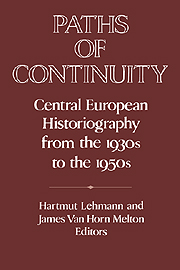Book contents
- Frontmatter
- Introduction: Continuities in German Historical Scholarship, 1933-1960
- 1 German Historiography from the 1930s to the 1950s
- 2 Friedrich Meinecke (1862-1954)
- 3 Change and Continuity in German Historiography from 1933 into the Early 1950s: Gerhard Ritter (1888-1967)
- 4 Hans Rothfels (1891-1976)
- 5 Franz Schnabel (1887-1966)
- 6 Heinrich Ritter von Srbik (1878-1951)
- 7 “Historical Social Science” and Political Myth: Hans Freyer (1887-1969) and the Genealogy of Social History in West Germany
- 8 Some Observations on the Work of Hermann Aubin (1885-1969)
- 9 From Folk History to Structural History: Otto Brunner (1898-1982) and the Radical-Conservative Roots of German Social History
- 10 Werner Conze (1910-1986): The Measure of History and the Historian's Measures
- 11 Continuity, Innovation, and Self-Reflection in Late Historicism: Theodor Schieder (1908-1984)
- Index
Introduction: Continuities in German Historical Scholarship, 1933-1960
Published online by Cambridge University Press: 05 January 2013
- Frontmatter
- Introduction: Continuities in German Historical Scholarship, 1933-1960
- 1 German Historiography from the 1930s to the 1950s
- 2 Friedrich Meinecke (1862-1954)
- 3 Change and Continuity in German Historiography from 1933 into the Early 1950s: Gerhard Ritter (1888-1967)
- 4 Hans Rothfels (1891-1976)
- 5 Franz Schnabel (1887-1966)
- 6 Heinrich Ritter von Srbik (1878-1951)
- 7 “Historical Social Science” and Political Myth: Hans Freyer (1887-1969) and the Genealogy of Social History in West Germany
- 8 Some Observations on the Work of Hermann Aubin (1885-1969)
- 9 From Folk History to Structural History: Otto Brunner (1898-1982) and the Radical-Conservative Roots of German Social History
- 10 Werner Conze (1910-1986): The Measure of History and the Historian's Measures
- 11 Continuity, Innovation, and Self-Reflection in Late Historicism: Theodor Schieder (1908-1984)
- Index
Summary
The year 1945 was long viewed as a caesura in German history. Germany's military defeat, and its subsequent occupation, partition, and political and economic reconstruction, seemed to represent a radical break with the past. The idea of 1945 as a “Stunde null” A zero hour when German history, freed from the burden of its past, began anew, had obvious appeal. To the vanquished Germans it promised historical redemption amid the rubble of defeat; to the triumphant allies it seemed to frame the finality of their victory.
But however useful in its postwar context, Stunde null was at heart an ahistorical concept. Germany after 1945 was not a tabula rasa, least of all in the composition of its intellectual and academic elites. Here the continuities are particularly striking in the case of the German historical profession, the subject of this book. In what was to become the Federal Republic of Germany, most historians who had occupied academic chairs under the National Socialist regime retained their positions after 1945. Even those scholars who were suspended after the war were often able to resume their careers in the 1950s, while conversely, few of those who had fled the Nazis returned to German academic life after the war. Another path of continuity was the generation who did not obtain academic posts until after 1945, but who had nonetheless received their historical training during the Nazi years. In one way or another, their experiences prior to 1945 profoundly shaped their subsequent lives, work, and careers.
- Type
- Chapter
- Information
- Paths of ContinuityCentral European Historiography from the 1930s to the 1950s, pp. 1 - 18Publisher: Cambridge University PressPrint publication year: 1994
- 1
- Cited by



